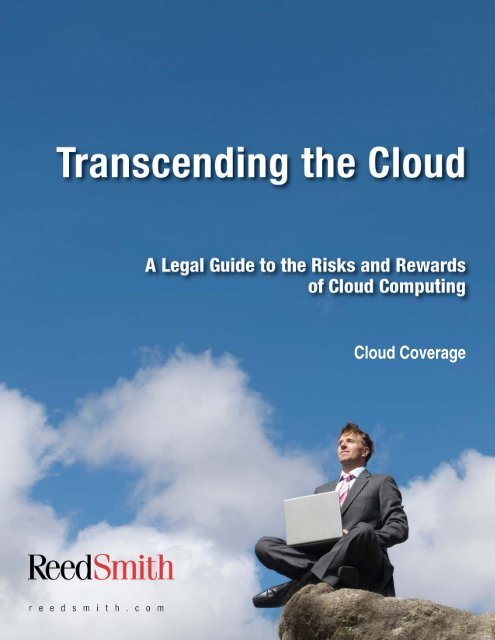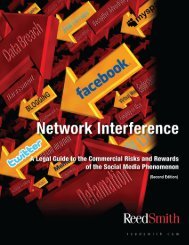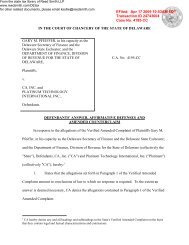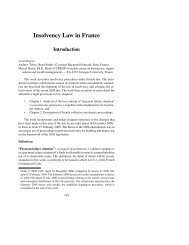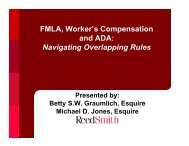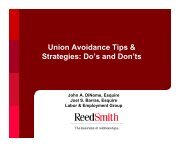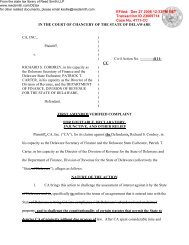Cloud Coverage - Reed Smith
Cloud Coverage - Reed Smith
Cloud Coverage - Reed Smith
You also want an ePaper? Increase the reach of your titles
YUMPU automatically turns print PDFs into web optimized ePapers that Google loves.
<strong>Cloud</strong> <strong>Coverage</strong>
Transcending the <strong>Cloud</strong> – A Legal Guide to the Risk and Rewards of <strong>Cloud</strong> Computing<br />
<strong>Cloud</strong> <strong>Coverage</strong><br />
Authors<br />
Richard P. Lewis, Partner – rlewis@reedsmith.com<br />
Carolyn H. Rosenberg, Partner – crosenberg@reedsmith.com<br />
Introduction<br />
Where clouds form, rain follows. Insurance should be there<br />
to protect you. This article outlines steps to consider so that<br />
coverage holds when the rain hits.<br />
<strong>Cloud</strong> Computing may create new risks and exposures,<br />
financially as well as reputationally. Traditional and more<br />
recent insurance coverage may come into play. On the<br />
traditional insurance front, property, and specifically<br />
business interruption coverage, may be a natural place to<br />
look. These policies are designed to cover first-party<br />
exposures—loss to business. Other coverage to consider<br />
for claims made by third parties against a company—by<br />
stockholders, consumers, the government or other<br />
entities—include commercial general liability (“CGL”),<br />
professional liability, director and officer liability,<br />
employment practices, and fiduciary liability policies. More<br />
recently, data privacy and security policies (sometimes<br />
called "cyber" policies) should be considered as well.<br />
First-Party <strong>Coverage</strong> Issues<br />
<strong>Cloud</strong> Computing Purchasers<br />
The primary first-party exposure is to <strong>Cloud</strong> Computing<br />
consumers, where some event impacts their data or ability<br />
to access that data, causing them to lose income. Is this<br />
lost Business Income covered under standard first-party<br />
policies providing Business Income, Contingent Business<br />
Income or Service Interruption coverage<br />
Business Income coverage is designed to cover a<br />
policyholder for loss of profits and unavoidable continuing<br />
expenses—“Business Income”—during the period business<br />
is affected by damage to property through which the<br />
policyholder conducts operations. Contingent Business<br />
Income coverage is designed to cover a policyholder for<br />
lost Business Income when damage to property through<br />
which a third party conducts operations prevents that third<br />
party from providing services to the policyholder. Service<br />
Interruption coverage is designed to cover a policyholder<br />
for lost Business Income when certain enumerated<br />
services provided to the policyholder are interrupted,<br />
typically by damage to off-site transmission or generation<br />
equipment. Because it is unclear whether any of these<br />
coverages, as typically drafted, would cover a <strong>Cloud</strong><br />
Computing consumer for lost Business Income from<br />
damage to, or inability to access, their data, new coverages<br />
will need to be drafted.<br />
As to Business Income coverage, note first that such<br />
coverage is typically restricted to damage to property at (or<br />
within 1000 feet of) the premises, and it seems likely that<br />
any damage to property causing a <strong>Cloud</strong> Computing<br />
interruption would not be located at the premises of the<br />
policyholder: indeed, one of the prime advantages of <strong>Cloud</strong><br />
Computing is that the “property” is off-site. It is hard to<br />
predict where damage to data would be deemed to have<br />
taken place. Indeed, courts may not consider data to be<br />
property, susceptible to damage, at all.1 Relatedly, courts<br />
may find that data that simply cannot be accessed has not<br />
been damaged. Most courts, however, find that property<br />
that cannot be used for its intended purpose has been<br />
damaged.2<br />
Because a claim based on the inability to access data as a<br />
result of problems of a <strong>Cloud</strong> Computing provider would<br />
likely involve data or equipment off-site, it would appear to<br />
fit more naturally as a Contingent Business Income claim.<br />
Again, however, the policyholder would have to prove that<br />
damage to property caused the interruption.<br />
<strong>Cloud</strong> <strong>Coverage</strong> 1
Transcending the <strong>Cloud</strong> – A Legal Guide to the Risk and Rewards of <strong>Cloud</strong> Computing<br />
A claim under most Service Interruption provisions would<br />
fail because they are limited to the most common services<br />
provided a generation ago: electric, steam and telephone<br />
services. Further, most such provisions require property<br />
damage from a covered cause of loss.<br />
As to all of these coverages, computer or data-related<br />
losses are frequently (1) excluded; (2) subject to strange<br />
limitations;3 or (3) subject to extremely small sublimits.<br />
Relatedly, such coverages are frequently subject to dollar<br />
as well as time (e.g., 24 or 72 hours) deductibles.<br />
Redundancies in the operations of <strong>Cloud</strong> Computing<br />
providers will likely limit the duration of the problem,<br />
meaning that the deductibles swallow the potential<br />
coverage. Nonetheless, any problem may completely shut<br />
down a <strong>Cloud</strong> Computing consumer, causing them to lose<br />
a great deal of income. It may also cause the policyholder’s<br />
customers to turn elsewhere for a time after the<br />
interruption, perhaps permanently.<br />
What likely is needed is for policyholders with large <strong>Cloud</strong><br />
Computing exposure to purchase specialty insurance<br />
covering them for loss attributable to loss of, or inability to<br />
access, their data, above a clearly identified (and ideally<br />
small) deductible. Such coverage must include extensions<br />
for the period of time in which losses continue after the<br />
interruption because of loss of customer goodwill.<br />
Fidelity bond coverage (which is required by regulation in<br />
some industries) is also important to assess. Theft,<br />
extortion, and cyber-related loss may be covered. Fidelity<br />
bond policies have strict requirements for reporting a loss<br />
and filing proofs of loss. Failure to adhere to the deadlines<br />
can preclude coverage.<br />
Third-Party <strong>Coverage</strong> Issues<br />
Third-party exposures may include claims related to<br />
websites, data control, errors in privacy protection,<br />
defamation, theft, consumer class actions, securities claims<br />
and government investigations. Claims may be brought<br />
domestically and internationally. The availability of thirdparty<br />
coverage will depend on the type of claim and other<br />
terms and conditions in the policies. A brief explanation of<br />
potential policies includes:<br />
Director and Officer Liability <strong>Coverage</strong>—One can envision<br />
a potential claim against directors and officers of a<br />
company for failing to supervise a <strong>Cloud</strong> Computing<br />
initiative or for being "asleep at the switch," and thereby<br />
breaching their fiduciary duties. One can also imagine the<br />
Securities and Exchange Commission investigating, or<br />
shareholders suing, a company for insider trading,<br />
restatements, or financial misrepresentations in disclosures<br />
in connection with <strong>Cloud</strong> Computing investments, insider<br />
deals, or other exposures that cause a stock drop or<br />
serious financial problems. A D&O policy typically covers<br />
directors and officers for claims made against them when<br />
the company cannot indemnify them. The policy also<br />
reimburses a company for amounts it indemnifies the<br />
directors and officers and, if entity coverage is purchased,<br />
the policy is designed to cover securities claims made<br />
against the company. <strong>Coverage</strong> will depend on the specific<br />
terms, conditions, and exclusions in the policy. Companies<br />
should be vigilant in reviewing the coverage to narrow<br />
exclusions and seek coverage enhancements.<br />
Professional Liability/Errors and Omission <strong>Coverage</strong>—<br />
Professional liability coverage is designed to cover claims<br />
made against the company and its employees for alleged<br />
acts or omissions in the context of doing their jobs. This<br />
coverage should also be examined and negotiated to avoid<br />
specific exclusions that could impair coverage.<br />
Fiduciary and Employment Practices Liability <strong>Coverage</strong>—<br />
Employee benefit plans and stock option claims involving<br />
potential fiduciary and trustee liability may be covered<br />
under a fiduciary policy. And if employment practices<br />
claims such as discrimination, sexual harassment or hostile<br />
workplace environment are made, such coverage may be<br />
reviewed.<br />
Comprehensive General Liability <strong>Coverage</strong>—A CGL policy<br />
typically provides coverage for bodily injury and property<br />
damage, as well as for advertising and personal injury. The<br />
definition of “property damage” may exclude electronic data<br />
in some policies, and should be addressed as it may be<br />
possible to negotiate an endorsement to provide such<br />
coverage. “Personal injury” claims may include publication<br />
or utterances that violate an individual’s right of privacy or<br />
are defamatory or disparaging. Exclusions, however, may<br />
limit the breadth of coverage.<br />
Data Privacy and Security <strong>Coverage</strong><br />
Data privacy and security policies may provide both<br />
first-party and third-party coverage. For example, some<br />
technology, media, data privacy breach and professional<br />
liability policies provide coverage for first-party loss,<br />
including internal hacker attacks or business interruption,<br />
or expenses to maintain or resurrect data. <strong>Coverage</strong> for<br />
third-party loss may include reimbursement of defense<br />
costs and indemnification for judgments and settlements.<br />
The claims may include allegations of violations of privacy<br />
<strong>Cloud</strong> <strong>Coverage</strong> 2
Transcending the <strong>Cloud</strong> – A Legal Guide to the Risk and Rewards of <strong>Cloud</strong> Computing<br />
rights, and personal information, duties to secure<br />
confidential personal information under state and federal<br />
laws and regulations, breaches by employees or others,<br />
infringement of intellectual property rights, unfair<br />
competition, defamation and consumer protection, and<br />
deceptive trade practices statutes. The coverage may also<br />
include regulatory actions, lawsuits, and demands.<br />
<strong>Coverage</strong> may additionally apply to “breachless” claims,<br />
where a potential problem or disclosure can be fixed before<br />
it becomes a claim. The policies are relatively new,<br />
however, much as employment practices liability policies<br />
were 10 years ago. The data privacy and security policies<br />
are negotiable and should be analyzed with a coverage<br />
lens to reduce uncertainty and broaden coverage for<br />
targeted exposures.<br />
Maximizing the Potential for Insurance Recovery<br />
Although no policy is foolproof, the following steps can be<br />
taken to keep coverage umbrellas functioning. Working<br />
with knowledgeable coverage counsel:<br />
• Inventory all potential policies now. Review any<br />
indemnification agreements with vendors or third<br />
parties who may owe contractual obligations to the<br />
company.<br />
• Analyze the terms and conditions on a "what if" basis,<br />
so that companies can determine potential exclusions<br />
or terms and conditions that may impact recovery.<br />
• Compare policy forms on the market and negotiate a<br />
"wish list" of potential items to clarify and enhance<br />
coverage.<br />
• On an annual basis, take advantage of advances in<br />
the insurance market and be aware of coverage<br />
decisions in the courts.<br />
• If a breach, loss, or claim occurs, know whether,<br />
when, how and why to report a claim or potential<br />
claim.<br />
• Obtain consent to defense arrangements if the policy<br />
requires.<br />
• Keep the insurers informed of claim developments<br />
and respond to reasonable requests for information<br />
and cooperation.<br />
• Seek consent to settlements and payment of loss or<br />
judgments on a timely and informed basis.<br />
• Know the dispute resolution and choice of law<br />
provisions in the policies, including the excess<br />
insurers.<br />
With knowledge, vigilance, and persistence, cloud<br />
coverage—protection when it rains—is possible.<br />
<strong>Cloud</strong> <strong>Coverage</strong> 3
— Biographies of Authors —<br />
Richard P. Lewis, Partner – New York +1 212 205 6063 · rlewis@reedsmith.com<br />
Richard has experience litigating a wide variety of first- and third-party insurance coverage issues. He also<br />
has experience in international arbitrations, assisting policyholders in securing coverage under Bermuda<br />
forms. Richard frequently speaks and writes on insurance coverage issues. He is a Member of the faculty of<br />
the Practising Law Institute, focusing on property and business interruption issues. In addition, he<br />
co-authored the book "Business Income Insurance Disputes," (Aspen 2006).<br />
Carolyn H. Rosenberg, Partner – Chicago +1 312 207 6472 · crosenberg@reedsmith.com<br />
Carolyn frequently advises corporations, directors and officers, risk managers, insurance brokers, lawyers<br />
and other professionals on insurance coverage, corporate indemnification, and litigation matters nationwide<br />
and internationally. Carolyn also assists clients in evaluating insurance coverage and other protections when<br />
negotiating transactions and represents them in resolving coverage disputes. In addition, Carolyn is a<br />
member of the Social and Digital Media Task Force. She authored the Insurance Recovery chapter of the<br />
Social Media White Paper entitled "A Legal Guide to the Commercial Risks and Rewards of the Social Media<br />
Phenomenon." She is on the firm's Executive Committee, is Chair of the Audit Committee, and also serves<br />
on the firm's Talent Committee. Carolyn was selected by Corporate Board Member magazine as one of the<br />
country’s 12 Legal Superstars and the top D&O liability insurance lawyer in August 2001 and was confirmed<br />
as the nation's top D&O liability insurance lawyer by Corporate Board Member magazine in a feature on<br />
superstar corporate attorneys in July 2004. In addition, Carolyn has been recognized by Chambers USA<br />
2008-2010: America's Leading Lawyers for Business.<br />
Author Biographies 4
— <strong>Cloud</strong> Computing Task Force Leaders—<br />
Joseph I. Rosenbaum<br />
Partner and Chair, Advertising Technology & Media Law Group<br />
jrosenbaum@reedsmith.com<br />
+1 212 702 1303<br />
<strong>Cloud</strong> Computing Task Force Leaders 5
— Endnotes —<br />
<br />
1<br />
2<br />
3<br />
Ward Gen. Ins. Serves., Inc. v. Employers Fire Ins. Co., 7 Cal. Rptr. 3d 844, 850-51 (Cal. App. 2003) (“We fail to see how information, qua<br />
information, can be said to have a material existence, be formed out of tangible matter, or be perceptible to the sense of touch. To be sure, information is<br />
stored in a physical medium, such as a magnetic disc or tape, or even as papers in three-ring binders or a file cabinet, but the information itself remains<br />
intangible. Here, the loss suffered by plaintiff was a loss of information, i.e., the sequence of ones and zeroes stored by aligning small domains of magnetic<br />
material on the computer's hard drive in a machine readable manner. Plaintiff did not lose the tangible material of the storage medium. Rather, plaintiff lost<br />
the stored information. The sequence of ones and zeros can be altered, rearranged, or erased, without losing or damaging the tangible material of the<br />
storage medium.”); but see Hambrecht & Assocs., Inc. v. State Farm Lloyd’s, 119 S.W.3d 16 (Tex. App. Ct. 2003).<br />
American Guar. & Liab. Ins. Co. v. Ingram Micro, Inc., NO. 99-185, 2000 WL 726789 (D. Ariz. Apr. 18, 2000).<br />
Greco & Traficante v. Fidelity & Guar. Ins. Co., No. O52179, 2009 WL 162068, at *4-5 (Cal. App. Jan. 26, 2009) (concluding that mysterious loss of billing<br />
data, in absence of evidence that it had ever been “stored” on storage media, as required by the policy, and in the absence of damage to any computer<br />
equipment, was not direct physical loss to covered property).<br />
Endnotes 6


